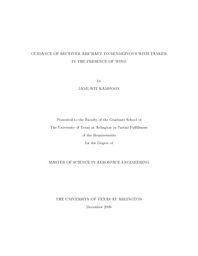
ATTENTION: The works hosted here are being migrated to a new repository that will consolidate resources, improve discoverability, and better show UTA's research impact on the global community. We will update authors as the migration progresses. Please see MavMatrix for more information.
Show simple item record
| dc.contributor.author | Kampoon, Jane-wit | en_US |
| dc.date.accessioned | 2010-03-03T23:30:54Z | |
| dc.date.available | 2010-03-03T23:30:54Z | |
| dc.date.issued | 2010-03-03T23:30:54Z | |
| dc.date.submitted | January 2009 | en_US |
| dc.identifier.other | DISS-10567 | en_US |
| dc.identifier.uri | http://hdl.handle.net/10106/2106 | |
| dc.description.abstract | This thesis work addresses the problem of aircraft rendezvous in the presence of prevailing wind for automated aerial refueling operations. A modified point-parallel rendezvous procedure is defined. The tanker aircraft performs a racetrack maneuver along a pre-specified refueling orbit. The receiver aircraft enters the refueling area through a fixed point and flies along the refueling line that is aligned with on of the straight legs of the race track. It is the responsibility to meet the tanker at the rendezvous point. A virtual target is used to define the trajectory of the refueling orbit. A nonlinear guidance algorithm is used to generate yaw rate commands for the tanker to follow the virtual target. An existing low-level controller is employed for the tanker to track the commanded yaw rate as well as commanded airspeed and altitude. The receiver aircraft has a controller to track a commanded trajectory relative to a moving reference frame. The concept of virtual tanker is introduced to synchronize the motion of the receiver along the refueling line with the tanker flying on the refueling orbit. The distance of the virtual tanker along the straight refueling line to the rendezvous point is synchronized with the distance-to-travel by the tanker to arrive the same point. The trajectory tracking controller of receiver flies the receiver at the precontract position relative to the virtual tanker until the virtual tanker rendezvous with the actual tanker. Then, the receiver switches to following the precontract position relative to the actual tanker. This establishes the aerial refueling formation of the aircraft. The guidance algorithms are implemented in a high fidelity simulation environment that includes the 6-DOF nonlinear models of both aircraft with terms for the dynamics effect of wind as well as the low-level controllers. The simulation of the refueling rendezvous in a realistic prevailing wind demonstrates that the nonlinear guidance logic coupled with the low-level controller is capable of flying the tanker along the refueling orbit. Further, the guidance algorithm based on the virtual tanker concept along with the trajectory tracking controller can successfully achieve the rendezvous of the receiver with the tanker even under presence of strong time-varying prevailing wind. | en_US |
| dc.description.sponsorship | Dogan, Atilla | en_US |
| dc.language.iso | EN | en_US |
| dc.publisher | Aerospace Engineering | en_US |
| dc.title | Guidance Of Receiver Aircraft To Rendezvous With Tanker In The Presence Of Wind | en_US |
| dc.type | M.S. | en_US |
| dc.contributor.committeeChair | Dogan, Atilla | en_US |
| dc.degree.department | Aerospace Engineering | en_US |
| dc.degree.discipline | Aerospace Engineering | en_US |
| dc.degree.grantor | University of Texas at Arlington | en_US |
| dc.degree.level | masters | en_US |
| dc.degree.name | M.S. | en_US |
| dc.identifier.externalLink | https://www.uta.edu/ra/real/editprofile.php?onlyview=1&pid=266 | |
| dc.identifier.externalLinkDescription | Link to Research Profiles | |
Files in this item
- Name:
- Kampoon_uta_2502M_10567.pdf
- Size:
- 2.601Mb
- Format:
- PDF
This item appears in the following Collection(s)
Show simple item record


